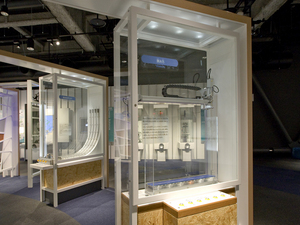Nagoya City Science Museum
TOP > Exhibition Guide > Keyword Search > Starting with "S" > spring > Elasticity / Elasticity of Springs
Elasticity / Elasticity of Springs



Purpose of Exhibition
There are two exhibits to learn about objects that have the property called "elasticity".
In the exhibition "Elasticity of Springs", a ball is shot with the force of a flat spring. You can compare how strong the elasticity of various materials is with how high the ball runs up a slope.
In the exhibition "Elasticity", the way metal balls bounce is compared by dropping them on various materials.
Additional Knowledge
[Spring and Elasticity]
A "spring" is used in various places around us. When referring to springs, you may imagine one with metal wires wound tightly, but there are many kinds of spring shapes. There are flat springs, whose shape is like a plate (used for a joint in a battery box), leaf springs (used for truck suspension), spiral springs and complicated springs such as paper clips for stationery and bulldog clips.
A spring is a product using "Elasticity". "Elasticity" is the property of recovery of an original size or shape when a transformed object has force applied to it from outside, and its force is taken away.
[Elastic Deformation and Plastic Deformation]
Many materials return to their original shape when the transformation is small, even if force is added externally. Transformation at this time is called elastic deformation.
On the other hand, there is transformation in which a shape does not return to its original shape even after the applied force is removed. This is called plastic deformation. Clay is a good example of this.
Although metal causes elastic deformation with a small external force, it causes plastic deformation with a greater force applied. What is happening at an atomic level? In elastic deformation, only because each atom transforms without its position, depending on the distance between atoms, it is possible to recover its original shape. In plastic transformation, atoms separate each from other and the positions between them are not well-balanced. As a result, they cannot return to their original shapes.
[Young's Modulus]
In elastic deformation, the applied force and size of transformation (for example, the length that a spring expands) is proportional. This is called "Hooke's Law".
When comparing materials, it is thought about the same relation by mending the unit area. The force per unit area is called "stress", and it is expressed by the unit of MPa (megapascal) or N/mm^2.
(1000000Pa=1MPa=1N/mm^2) *(Note)The ratio that divides the transformed size by the original size is called "strain". There is no unit. The stress and the strain are proportional, and can be expressed in the following
formula:
(stress) = (elastic modulus or modulus of elasticity) X (strain)In case of pulled stress or compressed stress particularly, the elastic modulus is called "Young's modulus".
GPa (gigapascal=1000MPa) is often used for the unit of Young's modulus. It needs a bigger force to make an elastic deformation for bigger value. Young's modulus is a decided value for each material, and the value never changes by any process such as heat treatment.
[Elasticity]
In the "Elasticity" exhibition, both the falling metal ball and the below material seem hard, and it doesn't seem like they transform. However, they transform slightly at an invisible level when they hit, and push each other when returning to the original shape. The metal ball jumps up by the force. Though hard materials are not transformed easily, they try to return to the original shape through large elasticity against the small transformation.
Generally, hard materials jump up high. Even though there are the same Young's modulus materials, the way of jumping is different according to the process of heat treatment, and it changes the hardness. However, this experiment is influenced by the ragged surface condition easily. We would like to inform you beforehand that the hardness and the bouncing are not exactly the same in this exhibition.
*(Note) mm^2 expresses "square millimeter".
Article by Keiko Ishida, curator
